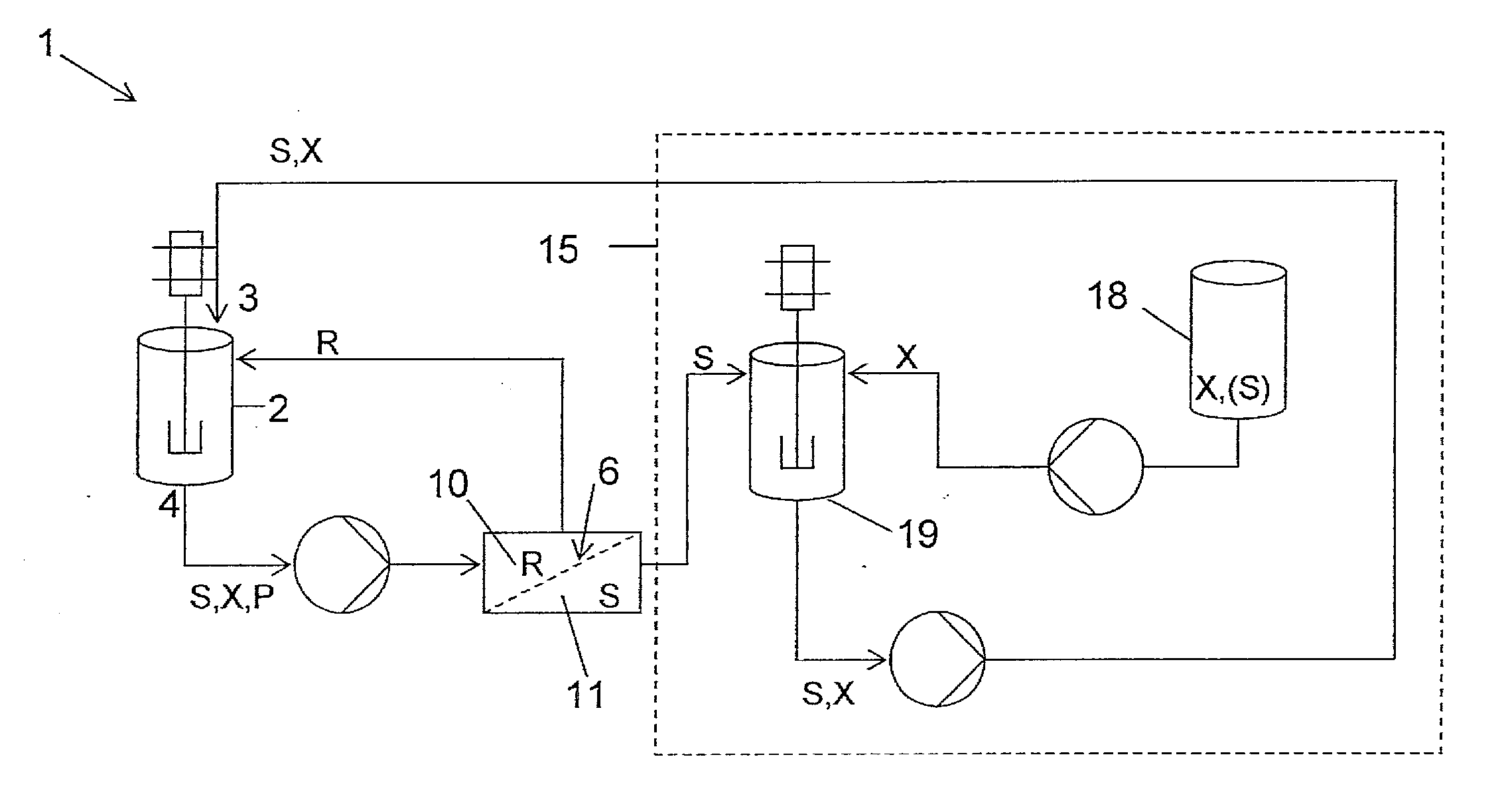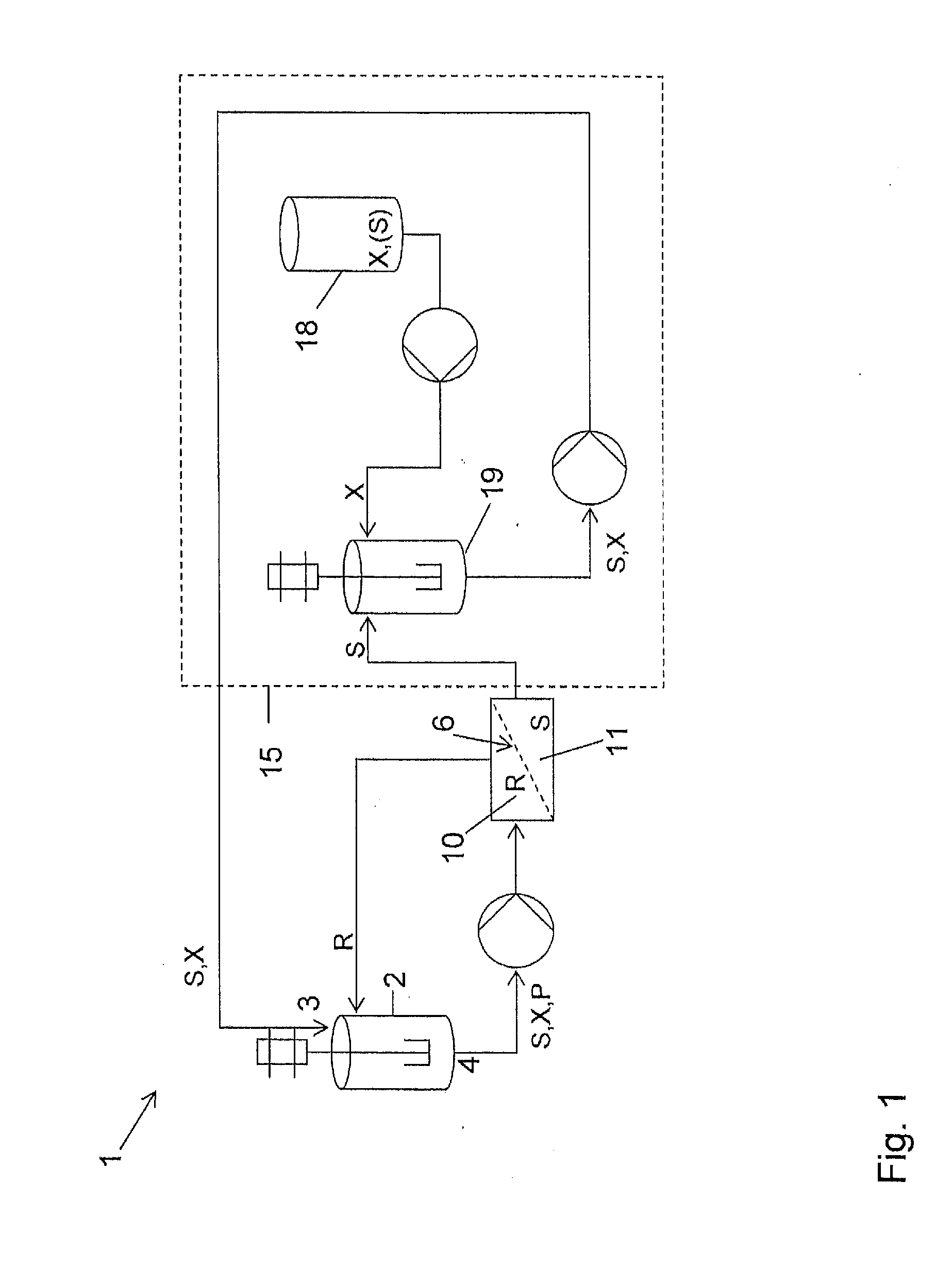Dilute chemical reaction process
a chemical reaction and dilution technology, applied in the field of dilution chemical reaction process, can solve the problems of serious constraints on the industry, serious reduction of product purity, and low concentration of certain reactions, and achieve the effects of reducing the volume of solvent used, reducing the quantity of solvent, and high reaction yield
- Summary
- Abstract
- Description
- Claims
- Application Information
AI Technical Summary
Benefits of technology
Problems solved by technology
Method used
Image
Examples
example 1
[0100]
[0101]The reaction shown in Scheme 1 is a model Mitsunobu lactonization to form a 13-membered ring.
[0102]The ring open precursor to cyclisation had a molecular mass of 595.75 g / mol and the lactone product had a molecular mass of 577.73 g / mole. A chemically cross-linked polyimide membrane (DuraMem™-200, Evonik-MET UK) was used to perform the in-situ solvent recovery (first membrane 6). The rejection of the substrate and product were both 99% and the reagents used to perform the Mitsunobu lactonization had a rejection of 99%.
[0103]The reaction was carried out as follows, using the equipment shown in FIG. 1. To a solution of triphenylphosphine (10.7 g) in dichloromethane (272 ml) under an atmosphere of nitrogen and cooled to 0° C. was added drop wise diisopropylazodicarboxylate (DIAD, 8.25 g) and the resulting mixture was stirred at 0° C. for 30 minutes. This solution was then added to the filtration loop feed tank, featuring in this experiment as reactor (2). The loop had been f...
example 2
[0106]The same reaction was carried out as follows, using the equipment shown in FIG. 1. To a solution of triphenylphosphine (10.7 g) in dichloromethane (272 ml) under an atmosphere of nitrogen and cooled to 0° C. was added drop wise diisopropylazodicarboxylate (DIAD, 8.25 g) and the resulting mixture was stirred at 0° C. for 30 minutes. This solution was then added to the filtration loop feed tank featuring here as the reactor (2). The loop had been fitted with a filtration cell containing a pre-conditioned DuraMem™ 200 membrane.
[0107]The solution in the filtration loop was subjected to constant volume diafiltration using a solution of lactonization starting material (1.49 g) dissolved in dichloromethane (500 ml) in mixing tank (19). The concentration of the starting material in mixing tank (19) was therefore 5 mmolar (200 l / mol). Permeate was recycled into mixing tank (19) and, in order to maintain the concentration of the diafiltration solution, to this was added concentrated lac...
example 3
[0108]The same model reaction was used to demonstrate the principle of this invention using a 0.9 nm TiO2 ceramic membrane (Inopor, Germany) in the equipment shown in FIG. 1. The rejection of the reaction starting material and product were both ≧95% and the reagents used to perform the Mitsunobu lactonization had a rejection of ≧81%.
[0109]To a solution of triphenylphosphine (10.7 g) in dichloromethane (272 ml) under an atmosphere of nitrogen and cooled to 0° C. was added drop wise diisopropylazodicarboxylate (DIAD, 8.25 g) and the resulting mixture stirred at 0° C. for 30 minutes. This solution was then added to the filtration loop feed tank, featuring in this experiment again as reactor (2). The loop had been fitted with a dry membrane.
[0110]The solution in the filtration loop was subjected to constant volume diafiltration using a solution of lactonization starting material (595 mg) dissolved in dichloromethane (500 ml) in mixing tank (19). The concentration of the starting materia...
PUM
| Property | Measurement | Unit |
|---|---|---|
| Fraction | aaaaa | aaaaa |
| Fraction | aaaaa | aaaaa |
| Fraction | aaaaa | aaaaa |
Abstract
Description
Claims
Application Information
 Login to View More
Login to View More - R&D
- Intellectual Property
- Life Sciences
- Materials
- Tech Scout
- Unparalleled Data Quality
- Higher Quality Content
- 60% Fewer Hallucinations
Browse by: Latest US Patents, China's latest patents, Technical Efficacy Thesaurus, Application Domain, Technology Topic, Popular Technical Reports.
© 2025 PatSnap. All rights reserved.Legal|Privacy policy|Modern Slavery Act Transparency Statement|Sitemap|About US| Contact US: help@patsnap.com



